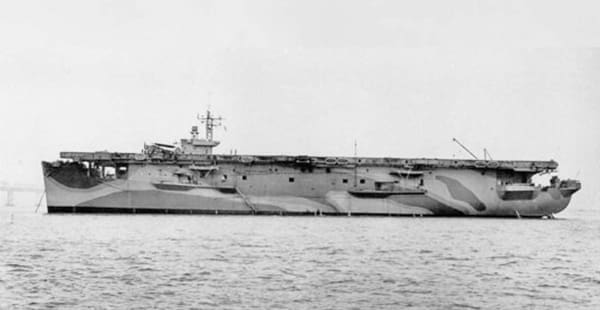History of Escort Carriers
Before entering World War II (WWII), the U.S. developed escort carriers to fortify its aircraft carrier convoys. These smaller ships could carry about one-third as many planes as aircraft carriers, but the Navy was able to produce them much more quickly. From 1941 to 1946, the Navy built about 120 escort carriers.
The ships made significant contributions during WWII. They aided in the Allied victory at the Battle of Leyte Gulf and helped sink 53 German U-boats in the Atlantic.
The Navy stopped building escort carriers shortly after WWII but continued using them into the early 1970s.
Escort Carriers’ History at a Glance
- Other Names/Classes: Baby flattops, Jeep carriers, Kaiser Jeeps
- Years of Operation: 1941 – 1971
- Wartime Operations: Korean War, World War II (WWII)
- Size of Crew: 910 – 916 men
- Size of Ship: 362 – 557 feet long
- Noteworthy Ships: USS Bogue, USS Casablanca
Notable Escort Carriers
Initially intended to serve as convoy support, escort carriers went on to become important in battle. In the years these ships were built and repaired, asbestos was often used on them. It helped insulate hulls, boilers and pipes. During WWII, the United States was using an average of 783 million pounds of asbestos per year.
USS Bogue (ACV-9/CVE-9/CVHE-9)
The USS Bogue joined the Navy in May 1942. It crossed the North Atlantic Ocean repeatedly, where the ship and its planes sank 13 German and Japanese submarines. The escort carrier relocated to the Pacific Ocean in 1945, where it helped return servicemen home. The Navy removed it from commission in 1946.
Given the Navy’s widespread use of asbestos during WWII, the USS Bogue and other escort carriers from the Bogue class were likely built with asbestos materials.
USS Casablanca (CVE-116)
The USS Casablanca was launched in 1943, joining the Pacific fleet. It largely served as a transport for passengers and aircraft. It was the first of 50 escort carriers in the Casablanca class. This was the largest class of escort carriers — they could carry 28 airplanes and 749 service members. As a whole, the class fought in both the Pacific and Atlantic Oceans.
As with the Bogue class of escort carriers, the Casablanca class was also likely built with asbestos materials. Those who built, repaired and served on the ships may have been exposed to the harmful mineral.
List of Escort Carriers
Escort carriers were built at a time when the Navy required widespread asbestos use on ships. Navy veterans, crew members and shipbuilders may have come into contact with these asbestos-containing materials.
Asbestos exposure can lead to mesothelioma and other illnesses. Mesothelioma symptoms can take up to 50 years to present. Those who served decades ago on the ships listed below may still be at risk of developing asbestos-related diseases.
| Name |
Hull |
Class |
Commissioned |
Fate |
| USS Admiralty Islands |
CVE-99 |
Casablanca |
6/13/1944 |
Scrapped, 1947 |
| USS Altamaha |
CVE-6 |
Attacker |
11/15/1942 |
Scrapped |
| USS Altamaha |
CVE-18 |
|
9/15/1942 |
Sold for Scrap |
| USS Attu |
CVE-102 |
Casablanca |
6/30/1944 |
Scrapped, 1947 |
| USS Badoeng Strait |
CVE-116 |
Commencement Bay |
11/14/1945 |
Scrapped, 1972 |
| USS Baffins |
CVE-35 |
Bogue |
7/20/1943 |
Transferred to Royal Navy |
| USS Bairoko |
CVE-115 |
Commencement Bay |
7/16/1945 |
|
| USS Barnes |
CVE-20 |
|
2/20/1943 |
Sold for Scrap |
| USS Barnes |
CVE-7 |
Attacker |
9/30/1942 |
Sold, 1947 |
| USS Bastian |
CVE-37 |
Bogue |
8/4/1943 |
Transferred to Royal Navy |
| USS Bismarck Sea |
CVE-95 |
Casablanca |
5/20/1944 |
Sunk, 1945 |
| USS Block Island |
CVE-8 |
Attacker |
1/9/1943 |
Scrapped, 1965 |
| USS Block Island |
CVE-21 |
Bogue |
3/8/1943 |
Scuttled, 1944 |
| USS Block Island |
CVE-106 |
Commencement Bay |
12/30/1944 |
Unknown |
| USS Bogue |
CVE-9 |
|
9/26/1942 |
Scrapped, 1960 |
| USS Bolinas |
CVE-36 |
Bogue |
7/22/1943 |
Transferred to Royal Navy |
| USS Bougainville |
CVE-100 |
Casablanca |
6/18/1944 |
Scrapped, 1960 |
| USS Breton |
CVE-23 |
|
4/12/1943 |
Scrapped, 1972 |
| USS Breton |
CVE-10 |
Bogue |
4/9/1943 |
Transferred to Royal Navy |
| USS Cape Esperance |
CVE-88 |
Casablanca |
4/9/1944 |
Sold,1959 |
| USS Cape Gloucester |
CVE-109 |
Commencement Bay |
3/5/1945 |
Scrapped |
| USS Card |
CVE-11 |
Bogue |
11/8/1942 |
Scrapped, 1971 |
| USS Carnegie |
CVE-38 |
Bogue |
8/12/1943 |
Transferred to Royal Navy |
| USS Casablanca |
CVE-55 |
Casablanca |
7/8/1943 |
Sold for Scrap |
| USS Charger |
CVE-30 |
Charger |
3/3/1942 |
Scrapped, 1969 |
| USS Chatham |
CVE-32 |
Bogue |
8/11/1943 |
Transferred to Royal Navy |
| USS Chenango |
CVE-28 |
Sangamon |
6/20/1941 |
Purchased by US Navy |
| USS Commencement Bay |
CVE-105 |
Commencement Bay |
11/27/1944 |
Scrapped, 1971 |
| USS Copahee |
CVE-12 |
Bogue |
6/15/1942 |
Scrapped,1961 |
| USS Coral Sea/Anzio |
CVE-57 |
Casablanca |
8/27/1943 |
Sold for Scrap |
| USS Cordova |
CVE-39 |
Bogue |
8/25/1943 |
Transferred to Royal Navy |
| USS Core |
CVE-13 |
|
12/10/1942 |
Scrapped, 1971 |
| USS Corregidor |
CVE-58 |
Casablanca |
8/31/1943 |
Scrapped, 1959 |
| USS Croatan |
CVE-14 |
Attacker |
2/27/1943 |
Scrapped, 1975 |
| USS Croatan |
CVE-25 |
|
4/28/1943 |
Scrapped, 1971 |
| USS Delgada |
CVE-40 |
Bogue |
11/20/1943 |
Scrapped, 1972 |
| USS Didrickson Bay/Tripoli |
CVE-64 |
Casablanca |
10/31/1943 |
Sold for Scrap |
| USS Edisto |
CVE-41 |
Bogue |
9/7/1943 |
Transferred to Royal Navy |
| USS Estero |
CVE-42 |
Bogue |
11/3/1943 |
Transferred to Royal Navy |
| USS Fanshaw Bay |
CVE-70 |
Casablanca |
12/9/1943 |
Scrapped, 1959 |
| USS Gambier Bay |
CVE-73 |
Casablanca |
12/28/1943 |
Sunk, 1944 |
| USS Gilbert Islands |
CVE-107 |
Commencement Bay |
2/5/1945 |
Scrapped, 1979 |
| USS Glacier |
CVE-33 |
Bogue |
8/1/1943 |
Transferred to Royal Navy |
| USS Guadalcanal |
CVE-60 |
Casablanca |
9/25/1943 |
Scrapped, 1959 |
| USS Hamlin |
CVE-15 |
Attacker |
12/21/1942 |
Transferred to Royal Navy, 1942 |
| USS Hoggatt Bay |
CVE-75 |
Casablanca |
1/11/1944 |
Scrapped, 1960 |
| USS Hollandia |
CVE-97 |
Casablanca |
6/1/1944 |
Scrapped, 1960 |
| USS Jamaica |
CVE-43 |
Ruler |
9/27/1943 |
Transferred to Royal Navy, 1943 |
| USS Kadashan Bay |
CVE-76 |
Casablanca |
1/18/1944 |
Scrapped, 1959 |
| USS Kalinin Bay |
CVE-68 |
Casablanca |
11/27/1943 |
Scrapped, 1946 |
| USS Kasaan Bay |
CVE-69 |
Casablanca |
12/4/1943 |
Scrapped, 1960 |
| USS Keweenaw |
CVE-44 |
Ruler |
10/25/1943 |
Transferred to Royal Navy, 1943 |
| USS Kitkun Bay |
CVE-71 |
Casablanca |
12/15/1943 |
Scrapped, 1946 |
| USS Kula Gulf |
CVE-108 |
Commencement Bay |
5/12/1945 |
Scrapped, 1971 |
| USS Kwajalein |
CVE-98 |
Casablanca |
6/7/1944 |
Scrapped, 1961 |
| USS Liscome Bay |
CVE-56 |
Casablanca |
8/7/1943 |
Sunk, 1943 |
| USS Long Island |
CVE-1 |
|
6/2/1941 |
Scrapped, 1977 |
| USS Lunga Point |
CVE-94 |
Casablanca |
5/14/1944 |
Scrapped, 1960 |
| USS Makassar Strait |
CVE-91 |
|
4/27/1944 |
Broken Up, 1961 |
| USS Makin Island |
CVE-93 |
Casablanca |
5/9/1944 |
Scrapped, 1947 |
| USS Manila Bay |
CVE-61 |
Casablanca |
10/5/1943 |
Scrapped, 1959 |
| USS Marcus Island |
CVE-77 |
Casablanca |
1/26/1944 |
Scrapped, 1960 |
| USS Matanikau |
CVE-101 |
Casablanca |
6/24/1944 |
Scrapped, 1960 |
| USS Midway/St. Lo |
CVE-63 |
Casablanca |
10/23/1943 |
Sunk, 1944 |
| USS Mindoro |
CVE-120 |
Commencement Bay |
12/4/1945 |
Sold,1960 |
| USS Mission Bay |
CVE-59 |
Casablanca |
9/30/1943 |
Scrapped, 1959 |
| USS Munda |
CVE-104 |
Casablanca |
7/8/1944 |
Scrapped, 1960 |
| USS Nassau |
CVE-16 |
|
8/20/1942 |
Sold for Scrap |
| USS Natoma Bay |
CVE-62 |
Casablanca |
10/14/1943 |
Scrapped, 1959 |
| USS Nehenta Bay |
CVE-74 |
Casablanca |
1/3/1944 |
Scrapped, 1960 |
| USS Niantic |
CVE-46 |
Bogue |
11/8/1943 |
Transferred to Royal Navy, 1943 |
| USS Ommaney Bay |
CVE-79 |
Casablanca |
2/11/1944 |
Sunk, 1945 |
| USS Palau |
CVE-122 |
Commencement Bay |
1/15/1946 |
Scrapped, 1960 |
| USS Perdido |
CVE-47 |
Bogue |
1/31/1944 |
Scrapped, 1973 |
| USS Petrof Bay |
CVE-80 |
Casablanca |
2/18/1944 |
Scrapped, 1959 |
| USS Point Cruz |
CVE-119 |
Commencement Bay |
10/16/1945 |
Scrapped, 1971 |
| USS Prince |
CVE-45 |
Bogue |
1/17/1944 |
Transferred to Royal Navy |
| USS Prince William |
CVE-31 |
|
4/9/1943 |
Scrapped, 1961 |
| USS Prince William |
CVE-19 |
Attacker |
4/28/1943 |
Transferred to Royal Navy |
| USS Puget Sound |
CVE-113 |
Commencement Bay |
6/18/1945 |
Sold,1960 |
| USS Pybus |
CVE-34 |
Bogue |
5/31/1943 |
Transferred to Royal Navy |
| USS Rabaul |
CVE-121 |
Commencement Bay |
|
Scrapped, 1972 |
| USS Rendova |
CVE-114 |
Commencement Bay |
10/22/1945 |
|
| USS Roi |
CVE-103 |
Casablanca |
7/6/1944 |
Scrapped, 1946 |
| USS Rudyerd Bay |
CVE-81 |
Casablanca |
2/25/1944 |
Scrapped, 1960 |
| USS Saginaw Bay |
CVE-82 |
Casablanca |
3/2/1944 |
Scrapped, 1959 |
| USS Saidor |
CVE-117 |
Commencement Bay |
9/4/1945 |
Scrapped, 1971 |
| USS Salamaua |
CVE-96 |
Casablanca |
5/26/1944 |
Scrapped, 1946 |
| USS Salerno Bay |
CVE-110 |
Commencement Bay |
5/19/1945 |
Scrapped, 1962 |
| USS Sangamon |
CVE-26 |
Sangamon |
10/23/1940 |
Purchased by US Navy |
| USS Santee |
CVE-29 |
Sangamon |
10/30/1940 |
Purchased by US Navy |
| USS Sargent Bay |
CVE-83 |
Casablanca |
3/9/1944 |
Scrapped, 1959 |
| USS Savo Island |
CVE-78 |
Casablanca |
2/3/1944 |
Scrapped, 1960 |
| USS Shamrock Bay |
CVE-84 |
Casablanca |
3/15/1944 |
Scrapped, 1958 |
| USS Shipley Bay |
CVE-85 |
Casablanca |
3/21/1944 |
Scrapped, 1959 |
| USS Siboney |
CVE-112 |
|
5/14/1945 |
Scrapped, 1971 |
| USS Sicily |
CVE-118 |
Commencement Bay |
2/27/1946 |
Scrapped, 1960 |
| USS Sitkoh Bay |
CVE-86 |
Casablanca |
3/28/1944 |
Scrapped, 1960 |
| USS Solomons |
CVE-67 |
Casablanca |
11/21/1943 |
Scrapped, 1946 |
| USS St. Andrews |
CVE-49 |
Bogue |
12/7/1943 |
Transferred to Royal Navy |
| USS St. George |
CVE-17 |
Attacker |
6/14/1943 |
Transferred to Royal Navy |
| USS St. Joseph |
CVE-50 |
Bogue |
12/22/1943 |
Transferred to Royal Navy |
| USS St. Simon |
CVE-51 |
Bogue |
12/31/1943 |
Transferred to Royal Navy |
| USS Steamer Bay |
CVE-87 |
Casablanca |
4/4/1944 |
Scrapped, 1959 |
| USS Sunset |
CVE-48 |
Bogue |
11/19/1943 |
Sold for Scrap |
| USS Suwannee |
CVE-27 |
Sangamon |
7/16/1941 |
Purchased by US Navy |
| USS Takanis Bay |
CVE-89 |
|
4/15/1944 |
Sold for Scrap |
| USS Thetis Bay |
CVE-90 |
Casablanca |
4/12/1944 |
Scrapped, 1964 |
| USS Tinian |
CVE-123 |
Commencement Bay |
|
Scrapped, 1971 |
| USS Tulagi |
CVE-72 |
Casablanca |
12/21/1943 |
|
| USS Vella Gulf |
CVE-111 |
Commencement Bay |
4/9/1945 |
Scrapped, 1971 |
| USS Vermillion |
CVE-52 |
Bogue |
1/20/1944 |
Transferred to Royal Navy |
| USS Wake Island |
CVE-65 |
Casablanca |
11/7/1943 |
Scrapped, 1946 |
| USS White Plains |
CVE-66 |
Casablanca |
11/15/1943 |
Scrapped, 1958 |
| USS Willapa |
CVE-53 |
Ruler |
2/5/1944 |
Transferred to Royal Navy |
| USS Windham Bay |
CVE-92 |
Casablanca |
5/3/1944 |
Scrapped, 1960 |
| USS Winjah |
CVE-54 |
Bogue |
2/18/1944 |
Transferred to Royal Navy |
Asbestos Use on Escort Carriers
Like other Navy ships of the era, escort carriers were likely to contain asbestos. The military required the use of asbestos in hundreds of applications, especially aboard Navy ships. Common asbestos products included:
Asbestos was also common in military aircraft, which escort carriers transported. These provided additional sources of asbestos exposure for those aboard the ships.
Who Was at Risk of Asbestos Exposure on Escort Carriers?
Because asbestos was so widespread on ships, many veterans and other crew members may have been at risk of occupational asbestos exposure. The risk was greater during the maintenance and repair of asbestos products. Airborne asbestos fibers pose a greater hazard because once inhaled, they can become embedded in the body.
Here are some occupations that were at risk of asbestos exposure on escort carriers:
Many of these workers who were exposed to asbestos later developed mesothelioma and other related diseases.
Compensation for People Exposed on Escort Carriers
Those who developed cancer, like mesothelioma, from asbestos exposure on escort carriers may have options for compensation. They may qualify to file:
- Lawsuits against the companies that manufactured the asbestos product that exposed them
- Trust fund claims against companies bankrupted by asbestos litigation
- VA claims to receive monthly disability compensation
A mesothelioma lawyer can help you determine which avenue of compensation works best for your case.







